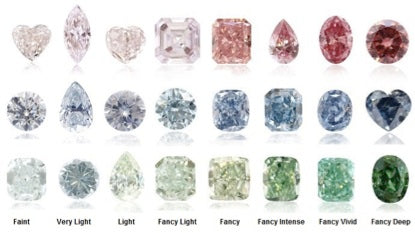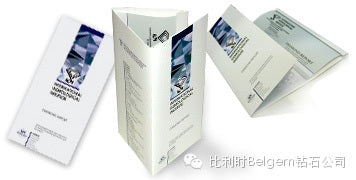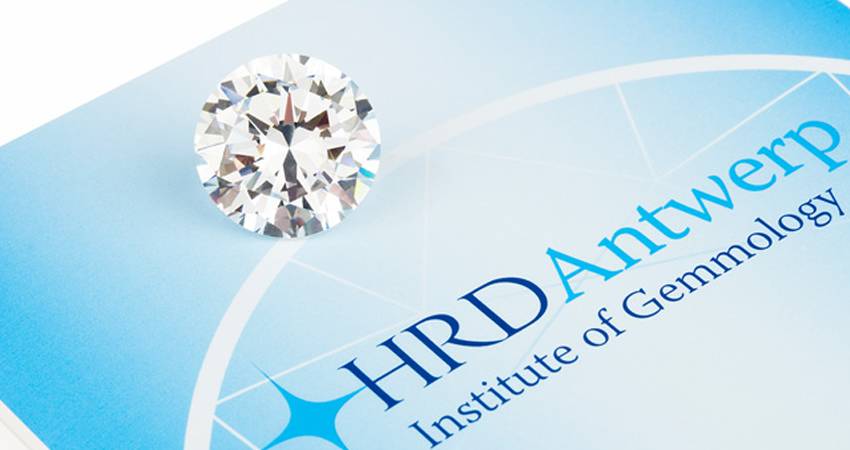
Most diamonds are either colorless or with a slight yellow tint. However, diamonds can also occur in a variety of other hues, such as red, blue, or pink—these are known as fancy colored diamonds.
In terms of traditional white (colorless) diamonds, the highest color grade is D, which represents complete colorlessness. This is followed by grades E, F, G, H, I, J, K, and L, with each successive grade showing an increasing presence of yellow or brown tones. The further down the scale, the more noticeable the color becomes.
Grading a diamond's color is an extremely delicate process, especially for the higher color grades such as D, E, and F. Accurate color determination can only be made in a fully enclosed darkroom within a professional gemological laboratory, using a diamond light with a color temperature of 6500K. Under such controlled conditions, experienced gemologists compare the diamond to master stones in order to assign the correct color grade.
Once a diamond is set in jewelry, however, and viewed under natural daylight, even trained eyes may find it difficult to distinguish between grades like D, E, and F—let alone tell the difference between lower grades such as I, J, or K. For the average person, the color variations are often subtle and barely noticeable.
After 20 years of experience in the industry, I’d like to share a small but valuable tip. Below is a comparison of three set diamonds we selected—D color, H color, and J color.
-
The first group of photos was taken under laboratory lighting conditions, and as you can see, the color differences are minimal.
-
The second set of photos shows how the diamonds appear under regular lighting in everyday wear—and the difference is almost imperceptible.
If you're with a limited budget, there's no need to obsess over top color grades. Once a diamond is set, the visual difference in color becomes very subtle. Instead, consider allocating more of your budget toward a larger carat weight, which will give you a more noticeable visual impact.
除了常规颜色的钻石以外,最近成为热门话题的还有各种彩钻。 例如日前在苏富比拍卖会上创造纪录的粉红之星,则不在传统的颜色分级当中。彩钻的颜色有自己的分级标准,根据其颜色的浓度可以被分为
In addition to traditional colorless diamonds, fancy colored diamonds have recently become a hot topic. For example, the Pink Star, which broke records at a recent Sotheby’s auction, falls outside the standard color grading scale.
Colored diamonds follow their own grading system, which is based on the intensity of their color. Depending on the depth and vividness of the hue, they are typically classified into the following categories:
Faint→Verylight→Light→Fancylight→Fancy→Fancydark→Fancyintense→Fancyvivid→Fancydeep

尽管深彩在所有彩钻中是颜色最浓的,但是艳彩的视觉效果才是最绚烂的,也是所有彩钻中价值最高的等级。
Although Fancy Deep diamonds show the deepest color saturation among all fancy colored diamonds, it is the Fancy Vivid grade that delivers the most brilliant and striking visual effect. As a result, Fancy Vivid is considered the most valuable grade among all fancy color diamonds.
How are fancy colored diamonds formed?
Different causes result in different diamond colors:
-
When nitrogen atoms replace some of the carbon atoms in the diamond's crystal structure, yellow diamonds are formed.
-
When boron is absorbed, the result is a blue diamond.
-
If the diamond's crystal lattice is distorted, it can produce pink or green diamonds, depending on the specific type of distortion.
-
Black diamonds, on the other hand, owe their color simply to being filled with dark inclusions.
According to statistics from experts, for every 100,000 gem-quality diamonds mined, only one might be a fancy colored diamond—a rarity with an occurrence rate of just 1 in 100,000. Among fancy colored diamonds, yellow, brown, and green are relatively more common. Others like pink, red, and blue are extremely rare and often considered once-in-a-lifetime finds.





